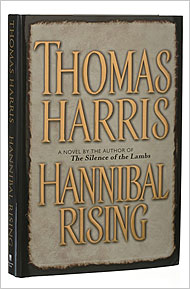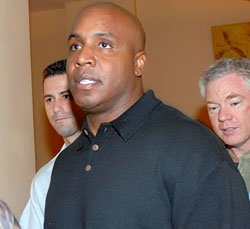
Friday, December 08, 2006
http://www.chroniclesmagazine.org
The Rockford Files
WMDs: Found!
Federal authorities today announced that they have located weapons of mass destruction and apprehended a man who was prepared to use them.
Where were they found? Baghdad? Tikrit? Sadr City? No.
Rockford, Illinois.
This afternoon, in federal court in Chicago, Derrick Shareef (a.k.a. Talib Abu Salam Ibn Shareef) was arraigned on one count of attempting to damage or destroy a building by fire or explosion and one count of attempting to use a weapon of mass destruction. He allegedly planned to set off four grenades in Rockford’s largest shopping center, CherryVale Mall, on December 22, at the height of the Christmas shopping season.
A federal affidavit discussing the plot, with numerous quotations from Shareef, can be downloaded as a PDF here, or viewed online here.
Set aside for the moment the absurdity of classing hand grenades as weapons of mass destruction. Instead, take a quick look at the hundreds of news stories on this case that have appeared on Google News. Notice a pattern?
While many of them mention that Shareef wanted to engage in “violent jihad,” not a single one, at the time of this writing, mention that Shareef is a Muslim, nor that he is black. Private sources indicate that he is a member of the Nation of Islam, but, if so, he’s a peculiar one at that: Throughout the affidavit, the federal agent quotes Shareef discussing his beliefs in Arabic Muslim terms (Umma, Kafirs, masjid, Jumma, mujahideen).
(UPDATE (5:00 P.M.): News stories are finally beginning to mention that he is a convert to Islam. His race is still missing from the stories, however.)
The news reports also ignore the explicit statements Shareef makes about his purpose in planning the attack:
“I swear by Allah man, I’m down for it too, I’m down for the cause, I’m down to live for the cause and die for the cause, man.”
“I’m ready man, these Kafirs [a term translated as “infidel”] don’t give a damn about us, niggers don’t care what happens to the Umma [an Arabic word meaning community or nation that is commonly used to mean the collective nation of Islamic states], about sisters getting raped, about brothers losing their (UI). They don’t care, man.
All they care about is (UI). . . I probably would have eventually ended up just stabbing the shit outta some Jews or something. Just stabbing them niggers with a steak knife. Dude, I ain’t gonna lie. Because during that war with Hezbollah, man, I had already started to look at synagogues out here and in the DeKalb area and everything. I was looking at synagogues, I was doing Mapquest. . . . One of them was down the block from the masjid [mosque], I knew that they do their thing on Saturdays, right. I was like, I’m gonna lay low out here, I’m gonna camp out overnight, be out there on Friday night after Jumma” [Friday payer] or Saturday morning about 12:00 or 1:00 o’clock., I be there. And as soon as I see them fools going in the building, I had planned on trying to grab one, depending on how it was, niggers trying to run in the building all at once and open up shop, I was just going to go over there and shank one or two of them.”
“I don’t think it’s gonna be gloomy nationwide like 9/11 . . . ”
“If Allah wills a lot of people around that garbage can, that place is crowded.” [Shareef planned to drop the grenades, set for a short time delay, into concrete garbage cans, which would act like shrapnel when the grenades exploded]
“This may be my last will and testament, the last words that I have spoken to those who know me, to those who do not know me. My name is Talib Abu Salam Ibn Shareef. I am 22 years of age. I am from America, and this tape is to let you guys know, who disbelieve in Allah, to let the enemies of Islam know, and to let the Muslims alike know that the time for jihad is now. . . . Be strong, oh Mujahideen. Be strong oh brothers who want to fight for jihad. . . . This is a warning to those who disbelieve, that we are here for you, and I am ready to give my life. . . . May Allah protect me on this mission we conduct. . . . So do not cry, do not mourn for me. Do not believe what the kafir [infidel] will say about me when you read in the newspapers and when you see the television articles about me. Do not believe this. Understand that your son is a strong man. . . who believes and fears his Lord to the degree that he will give his life.”
So, what’s going on here? Why the radio silence from the major media on the link to Islam? Are we to believe that, because federal authorities say that Shareef was not part of a broader conspiracy, Islam had nothing to do with it? Or that, because he is a Black Muslim, Islam had nothing to do with it?
Islam, as readers of Chronicles know, and as anyone with any understanding of history is aware, is not a religion of peace. There is no reason not to take Shareef’s statements about his motivations at face value, and there are very good reasons to publicize them.
Out here in the middle of the American heartland, Islam has a greater foothold than many people realize. I’ve discussed this at length, most recently in the December 2006 issue of Chronicles. Aaron Wolf and I spent a day at the local mosque and Islamic school in February 2002, and I’ve written about that day here and here. Read those pieces. See what Muslim students are learning in Rockford, Illinois. Pay attention to the words of a prominent Muslim doctor, the chairman of the board of the school, when he praises Osama bin Laden and talks about the way in which sharia will be imposed in the United States. Look at the understanding of peace—the submission of all men to Allah—that the current imam at the mosque preaches.
Hand grenades may not qualify as weapons of mass destruction (except under federal law), but that doesn’t mean that WMDs aren’t found here in Rockford. Ours are just flesh and blood.
UPDATE (4:30 P.M.): It appears that the masjid and the synagogue that Shareef mentions as “down the block” from each other were both in DeKalb, home of Northern Illinois University. If so, that would mean that Shareef is talking about the Islamic Society of Northern Illinois University, which is not a Black Muslim organization, but rather an outpost of the “religion of peace.” That would explain Shareef’s discussion of Islam in Arabic terms.
UPDATE (11:30 P.M.): Well, you read it here first, but WIFR-23’s Tina Stein gets the credit for breaking the story in the mainstream media. Shareef was a convert to the Nation of Islam seven years ago (at about the age of 15). His mother and father, who are divorced, are both black. His father, and several members of his father’s family, are members of the Nation of Islam. The Chicago Daily Herald also has a detailed report.
I was interviewed live tonight at 10 by Bryan Henry of WIFR-23, and if they put up video, I’ll link to it. (The segment was rather long—over five minutes—so they may not.) Another local station came to the office this evening and took about a half-hour of footage, but they did not use it at 10. I’m not sure why; the cameraman was very pleased, but perhaps they were looking for a somewhat different take on things. I’ll let you know whether they use any of the footage tomorrow.
/Illinois/Winnebago County/Rockford print permanent link writebacks (3)












